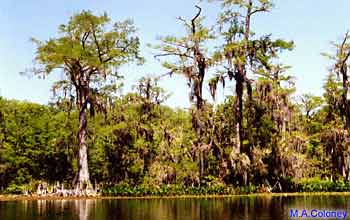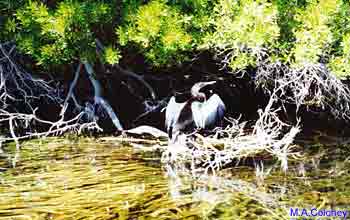| Apple snail habitats - Florida swamps | 2 |
|
|
 The Wakulla River, a typical habitat of Florida apple snails (Pomacea paludosa). A view of the river bank, with cypress trees, Spanish moss hanging from the trees, and arrow-leafed pickerel weed. |
 This is a very small island in the river, with a good view of cypress "knees" -- upward protrusions of the cypress roots, and one of the unique characteristics of Florida swamps. It is believed that the trees derive extra oxygen with the knees, since cypress typically grow in the water or at its swampy edge. Cypress knees are a common location for apple snail eggs (Pomacea paludosa). The bird on the knee is an Anhinga. |
 This is a Limpkin wading in the shallows in search of apple snails (Pomacea paludosa), near a stand of pickerel weed. The grassy-looking plant through which the Limpkin is wading is eel grass, which grows on the sandy bottom of fresh-water rivers. The pickerel weed has beautiful spikes of blue flowers, and is very common in rivers and swamps. |
 This is an Anhinga. Although they are water birds, they have no oil in their feathers, so after swimming they must spread their wings to dry before they can fly. The Anhinga is also called the "Snake Bird" because it swims underwater, often with only its snakelike neck and narrow head above water. The Anhinga catches fish by spearing them with its sharp beak, then tossing them into air to be swallowed. You can see the eel grass underwater very clearly. The trees are wax myrtle, very typical of north Florida. |
 Cypress trees, with a pair of wood ducks. You can also see the Spanish moss hanging down on the left. |
Text and photographs: Mary Adore Coloney. (pictures not licenced under creative commons) |
|
|
|
Except where otherwise noted, this page is licensed under a Creative Commons Attribution-NonCommercial-ShareAlike 2.5 License . http://www.applesnail.net |
|